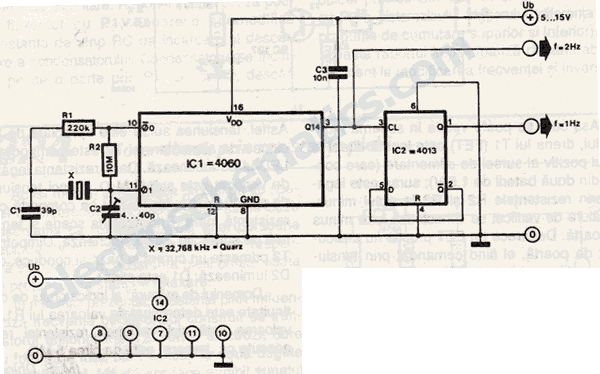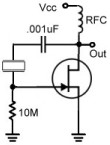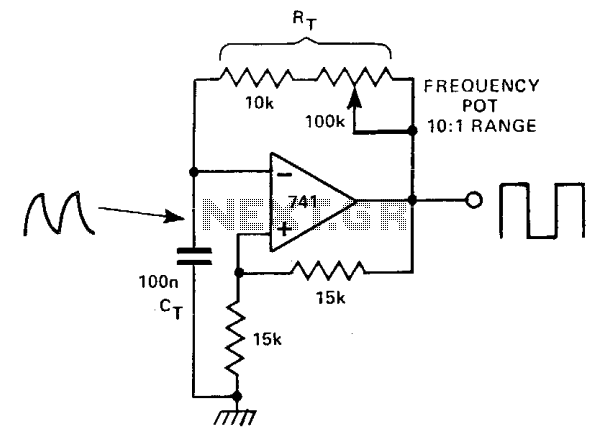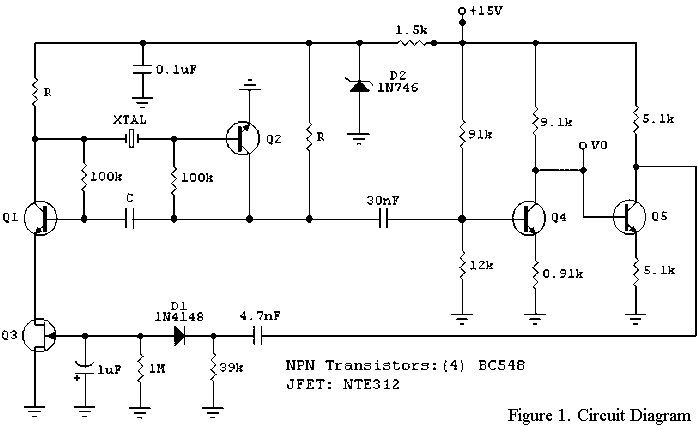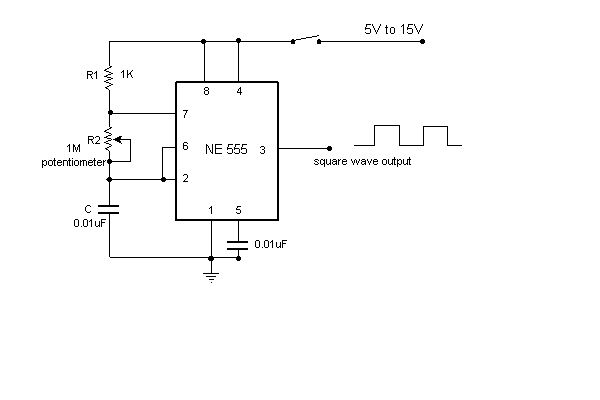
Wien bridge oscillator II
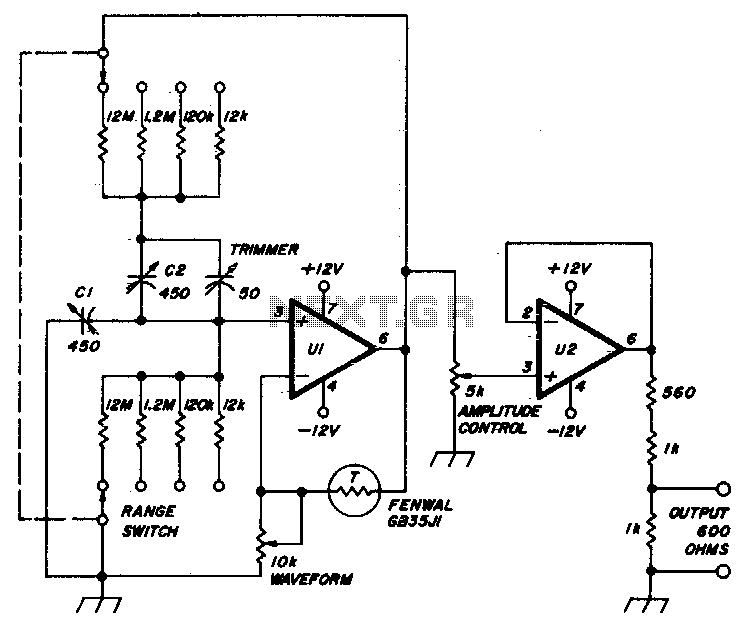
A Wien bridge sine-wave oscillator utilizing two RCA CA3140 operational amplifiers operates within a frequency range of 30 Hz to 100 kHz, achieving less than 0 percent total harmonic distortion. A 10k potentiometer is used for waveform optimization. Capacitors C1 and C2 comprise a two-gang, 450-pF variable capacitor with its frame electrically isolated from ground. The maximum output into a 600-ohm load is approximately 1 volt RMS.
The Wien bridge oscillator is a well-established circuit design known for generating low-distortion sine waves. The configuration employs two RCA CA3140 operational amplifiers, which are precision devices capable of operating over a wide frequency range while maintaining low distortion levels. This oscillator can be tuned to produce frequencies from 30 Hz to 100 kHz, making it suitable for various applications, including signal generation and testing.
The key components of the circuit include a resistive network and a capacitive network. The resistive network typically consists of resistors that set the gain of the op-amps, while the capacitive network, which includes the variable capacitors C1 and C2, determines the frequency of oscillation. The two-gang, 450-pF variable capacitor allows for fine-tuning of the frequency by adjusting the capacitance, which is critical for achieving the desired output waveform.
The use of a 10k potentiometer in the feedback loop of the operational amplifiers allows for real-time adjustment of the gain, which is essential for stabilizing the oscillation and ensuring that the output waveform is optimal. The circuit's design ensures that the output remains stable and free from distortion, achieving a total harmonic distortion of less than 0 percent.
The output stage of the oscillator is designed to drive a load of 600 ohms, providing a maximum output voltage of approximately 1 volt RMS. This output level is suitable for interfacing with various devices and circuits, making the Wien bridge oscillator a versatile tool in both laboratory and practical applications. The overall design emphasizes stability, low distortion, and ease of frequency adjustment, making it an effective solution for sine wave generation.Wien bridge sine-wave oscillator using two RCA CA3140 op amps cover» 30 Hz to 100 kHz with less than 0 percent total harmonic distortion. The 10k pot is adjusted for the best waveform Capacitor CI and C2 are a two-gang, 450-pF variable with its frame isolated from ground. Maximum output into a 600-ohm load is about 1 volt rms. 🔗 External reference
The Wien bridge oscillator is a well-established circuit design known for generating low-distortion sine waves. The configuration employs two RCA CA3140 operational amplifiers, which are precision devices capable of operating over a wide frequency range while maintaining low distortion levels. This oscillator can be tuned to produce frequencies from 30 Hz to 100 kHz, making it suitable for various applications, including signal generation and testing.
The key components of the circuit include a resistive network and a capacitive network. The resistive network typically consists of resistors that set the gain of the op-amps, while the capacitive network, which includes the variable capacitors C1 and C2, determines the frequency of oscillation. The two-gang, 450-pF variable capacitor allows for fine-tuning of the frequency by adjusting the capacitance, which is critical for achieving the desired output waveform.
The use of a 10k potentiometer in the feedback loop of the operational amplifiers allows for real-time adjustment of the gain, which is essential for stabilizing the oscillation and ensuring that the output waveform is optimal. The circuit's design ensures that the output remains stable and free from distortion, achieving a total harmonic distortion of less than 0 percent.
The output stage of the oscillator is designed to drive a load of 600 ohms, providing a maximum output voltage of approximately 1 volt RMS. This output level is suitable for interfacing with various devices and circuits, making the Wien bridge oscillator a versatile tool in both laboratory and practical applications. The overall design emphasizes stability, low distortion, and ease of frequency adjustment, making it an effective solution for sine wave generation.Wien bridge sine-wave oscillator using two RCA CA3140 op amps cover» 30 Hz to 100 kHz with less than 0 percent total harmonic distortion. The 10k pot is adjusted for the best waveform Capacitor CI and C2 are a two-gang, 450-pF variable with its frame isolated from ground. Maximum output into a 600-ohm load is about 1 volt rms. 🔗 External reference
